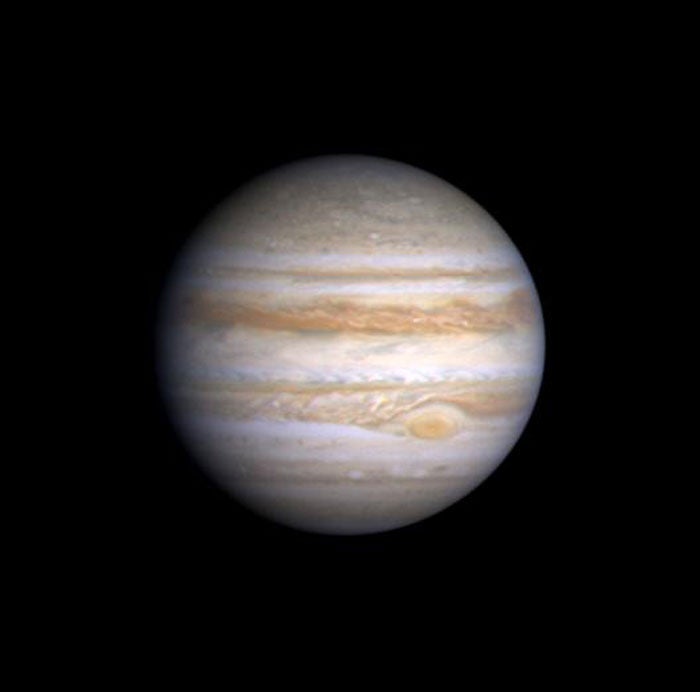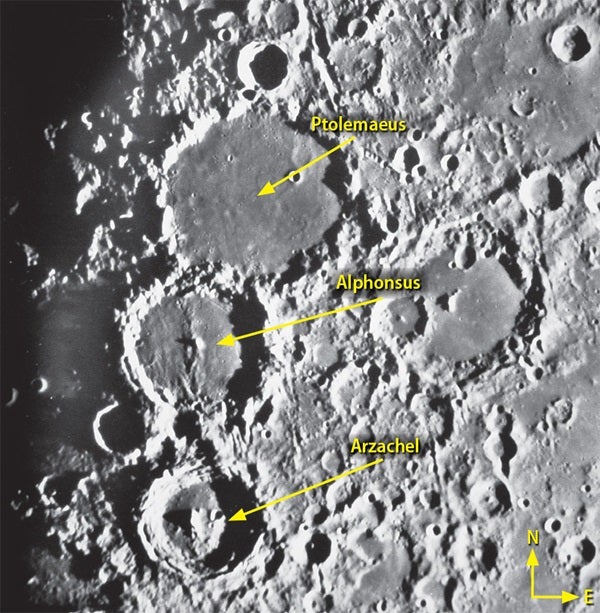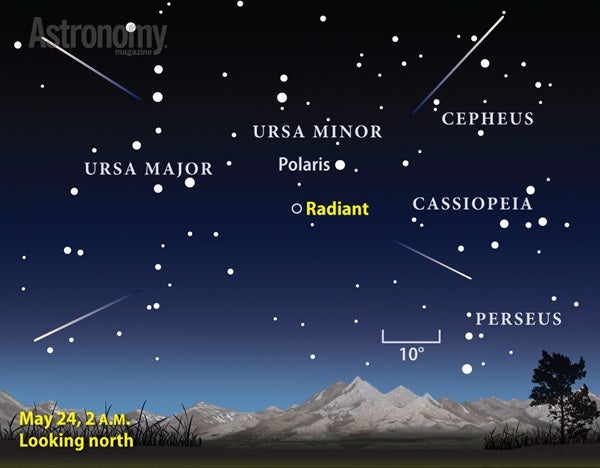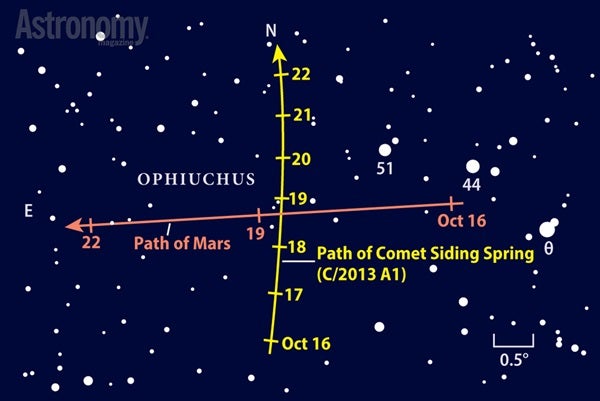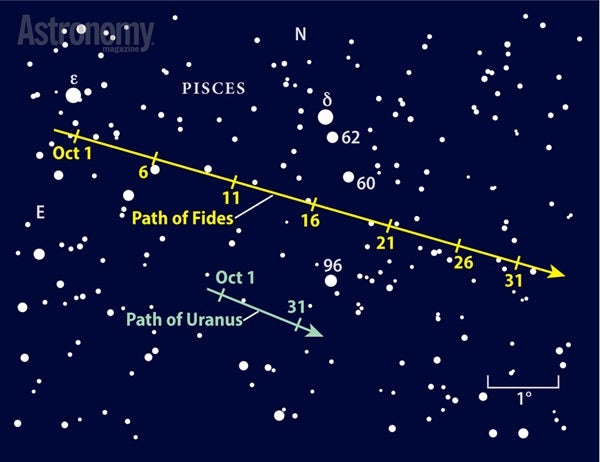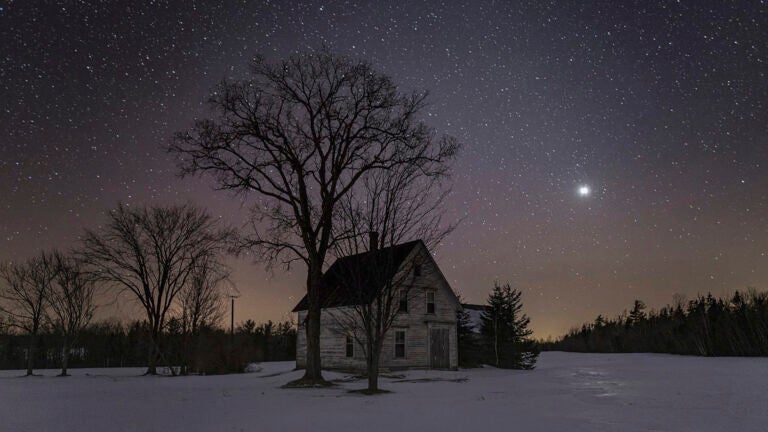of its more distant sister world, Neptune.
But the highlights of the month for North American observers have to be two dramatic eclipses — one of the Sun and one of the Moon. Before dawn October 8, the Full Moon treks through Earth’s shadow, which turns the bright orb a pretty shade of orange-red. Fifteen days later, on the afternoon of October 23, the New Moon passes in front of the Sun and blocks up to 81 percent of our star from view. For details about these impressive events, see “How to view October’s two spectacular eclipses” on p. 54.
Planetary observers can catch a glimpse of Mercury on October’s first few evenings. From 30° north latitude on the 1st, the planet sits 4° high in the west-southwest 30 minutes after the Sun goes down. (It’s a bit higher from farther south and a little lower from up north.) Mercury disappears a few days later as its orbit carries it deeper into twilight. It passes between the Sun and Earth on October 16 and then slides into the morning sky, where we will visit it later.
A far more obvious target lies higher in the evening sky. Saturn stands about 20° east of Mercury in early October and appears 10° above the horizon a full hour after sunset. At magnitude 0.6, the ringed planet shines bright enough for observers to see in the deepening twilight even if the dim background stars of its host constellation, Libra the Balance, remain hidden. A telescope should deliver decent views of Saturn’s ring system, which spans 35″ and tilts 22° to our line of sight.
Saturn dips lower in the sky with each passing day. Although it sets two hours after the Sun on the 1st, that drops to less than an hour in late October. The planet will pass behind the Sun from our perspective in mid-November. Its final stab at glory comes October 25 when a thin crescent Moon hangs a few degrees to Saturn’s upper left.
The name “Antares” derives from Greek and means “rival of Ares” (Ares being the Greek god of war, the same role played by Mars in the Roman pantheon). One look at the two objects’ colors will convince you that the Greeks were onto something. But the similar hues have totally different origins. Iron oxides on Mars’ surface preferentially reflect orange-red sunlight into space; the cool supergiant star Antares radiates most of its energy in the red part of the visible spectrum and at invisible infrared wavelengths.
Mars moves rapidly eastward relative to the background stars this month, allowing it to maintain its angular distance from the Sun. The planet sets three hours after our star throughout October. Unfortunately, Mars lies relatively far from us, so it appears tiny (6″ across) through a telescope and shows little, if any, detail.
The Red Planet traverses the southern part of Ophiuchus the Serpent-bearer during October’s first three weeks. On the 14th, Mars passes just 19′ north of 3rd-magnitude Theta (θ) Ophiuchi, a hot star with a distinct bluish color. The color contrast should stand out through binoculars, but a telescope will deliver the best views.
Mars has an even more impressive meeting on the 19th when Comet Siding Spring (C/2013 A1) skims within 81,000 miles of the planet. How rare is this event? Astronomers know of no comet that has ever come closer to either Mars or Earth.
Siding Spring should glow around 8th magnitude — roughly a thousand times dimmer than Mars — so you’ll need a scope and good viewing conditions to spot it. You can bet that the armada of spacecraft orbiting Mars and roving its surface will be watching the comet along with the thousands of excited amateur and professional astronomers here on Earth.
As Sagittarius sets in the southwest, Aquarius and its solar system tenant, distant Neptune, peak in the south. Although this constellation contains no bright stars, look for the so-called Water Jar asterism near its northern border with Pegasus. This group of four 4th- and 5th-magnitude stars — Zeta (ζ) Aquarii lies at the center of a triangle formed by Eta (η), Gamma (γ), and Pi (π) Aqr — appears conspicuous under a dark sky. If you scan 11° due south of Zeta, you’ll find 5th-magnitude Sigma (σ) Aqr. Neptune stands less than 1° west of this star.
The planet glows at magnitude 7.8, so it is easy to pick out through binoculars from a dark-sky site but can pose a challenge in 7x50s from the suburbs. A telescope at medium magnification reveals Neptune’s blue-gray disk, which appears 2.3″ across.
Head one constellation east of Aquarius, and you’ll land in Pisces the Fish, current home of Uranus. The distant world reaches opposition and peak visibility October 7, when it stands opposite the Sun in our sky and thus remains visible all night. Although the Full Moon appears nearby that night, its glare nearly vanishes during the morning hours as it slides into Earth’s shadow. At the height of the total lunar eclipse, the Moon lies 1° from the planet.
Even after opposition, Uranus remains a tempting target. The ice giant shines at magnitude 5.7 and appears highest in the south within an hour or so of midnight local daylight time throughout October. It’s an easy binocular object and even shows up to the naked eye under a dark sky.
Jupiter rises by 3 a.m. local daylight time October 1, when it lies in the eastern part of Cancer the Crab. It crosses into Leo on the 14th and ends the month 10° west-northwest of the Lion’s luminary, 1st-magnitude Regulus. (Jupiter then rises around 1 a.m.) Our solar system’s largest planet shines much brighter than the star, improving from magnitude –1.9 to –2.1 during October. In fact, it is the brightest point of light in the sky.
The giant world looks spectacular through a telescope, particularly as it climbs higher in the sky before dawn. Look for two parallel dark belts, one on either side of a brighter zone nearly coincident with the planet’s equator. Jupiter’s apparent diameter grows from 34″ to 36″ during October.
A telescope also shows as many as four bright moons. The orbital plane of these Galilean satellites tilts nearly edge-on to our line of sight this month, initiating a series of mutual events — occultations when one moon passes in front of another and eclipses when one moon enters another’s shadow. October marks the first of these in 2014 that occur with Jupiter far enough from the Sun to be visible. An event “season” occurs twice during each of Jupiter’s 12-year orbits around the Sun. The current one will continue through August 2015.
The best-timed occurrence for North American observers this month happens October 24 when Io occults Callisto. The six-minute event begins at 4:24 a.m. EDT. Three minutes later, Io’s disk lies completely inside Callisto’s larger one. (Observers will see the two disks merge and their total light output drop by nearly 20 percent.) Only viewers along the West Coast, where Jupiter has yet to rise, will miss out.
As October winds down, Mercury springs back into view before dawn. By the 26th, it stands 7° above the eastern horizon 45 minutes before sunrise and shines at magnitude 0.5. Binoculars will help you pick it out of the twilight. By the 31st, the innermost planet has brightened to magnitude –0.5 and has climbed a couple of degrees higher, making it much easier to spot. If you point a telescope at Mercury on the month’s final morning, you’ll see a half-lit disk measuring 7″ across.
Venus hides in the Sun’s glare all month. It passes behind our star October 25 and will return to view on evenings in early December.
Our nearest celestial neighbor often floods the sky with light. Although many deep-sky aficionados pack up their telescopes around the time of Full Moon, the brightly lit orb offers plenty of thrills to those willing to invest a little time. This month provides a great viewing opportunity on the evening of October 7 because most astronomy enthusiasts will be getting ready for the after-midnight total lunar eclipse. The prominent features don’t change much, however, a night or two removed from Full Moon.
The most distinctive characteristic is the pattern of light and dark areas that resembles a face to unaided eyes. The bright zones to the north and south are crustal highlands, pounded by solar system debris over the eons. The dark circular patches known as maria that give the Man in the Moon its eyes and mouth are huge impact basins. Their dusky color came later when lava from the molten interior welled up and flooded them.
Even the smallest telescope transforms the Full Moon into a real world. Use a filter to cut down on glare, or pump up the power to spread out Luna’s light. The magnificent ray system radiating from the crater Tycho will immediately grab your attention. The impact that excavated this 53-mile-wide bowl launched long streams of lighter highland material that extend nearly to the north pole. Less conspicuous sets of rays emanate from other craters. Generally, the brighter ones formed more recently.
Three prominent white splotches lie scattered among the maria on the Moon’s western half. The brightest of these craters is Aristarchus, which spans 25 miles and lies farthest north of the trio. The energy from its creation punched through a thin layer of lava and blasted out lots of light-hued crust. Copernicus (58 miles across) and Kepler (20 miles across) both have ray systems and large debris skirts draped around them. Although Tycho has a skirt, too, it’s tough to see this light material against the highland crust.
NO MOON BODES WELL FOR THE HUNTER’S PEAK
The sky should be nearly perfect for the predawn peak of the annual Orionid meteor shower October 21. The waning crescent Moon doesn’t rise until 5 a.m. local daylight time, and its 6-percent-lit phase won’t detract from the show in the following hour before twilight begins. Observers under a dark sky could see close to the maximum possible rate of 25 meteors per hour as Orion the Hunter rides high in the early morning sky. And if clouds interfere on the 21st, keep in mind that the shower often maintains near-peak levels for a couple of days on either side of maximum.
Orionid meteors originate from debris Comet 1P/Halley has shed during its many circuits of the Sun. When Earth crosses Halley’s orbit each October, friction with our atmosphere incinerates some of these dust particles, creating the “shooting stars.”
| WHEN TO VIEW THE PLANETS |
||
| Evening Sky |
Midnight | Morning Sky |
| Mercury (west) |
Uranus (south) |
Mercury (east) |
| Mars (southwest) |
Neptune (southwest) |
Jupiter (southeast) |
| Saturn (southwest) |
Uranus (west) |
|
| Uranus (east) |
|
|
| Neptune (southeast) |
|
|
Autumn’s often crisp, clear skies offer a cornucopia of comets this year. In the predawn sky, a binocular object passes near a bright star cluster as it makes its way across the winter Milky Way. Meanwhile, two modest telescopic targets wander through October’s evening sky.
The top event this month involves one of the evening objects. Comet Siding Spring (C/2013 A1) has a historic encounter with Mars on October 19 when the two pass within 81,000 miles of each other at
3 p.m. EDT. The Red Planet then shines at magnitude 0.9, while the comet glows around 8th magnitude. A 4-inch telescope at medium power should provide a great view of the pair from under a dark sky, but you’ll likely need twice that aperture if you observe from the suburbs.
The month’s other evening comet fares worse. Oukaimeden (C/2013 V5) should glow at 7th magnitude during October’s first week, but it lies close to the southwestern horizon during twilight. The comet made its closest approach to the Sun in late September, however, and there’s a chance that our star’s heat will cause an outburst.
You’ll have to be up before dawn to see Comet PANSTARRS (C/2012 K1), a 6th-magnitude object gliding across the Milky Way in Puppis. In mid-October, it appears in the same binocular field as the 6th-magnitude star cluster M93. A 4-inch scope will reveal a stubby tail spreading west from the comet’s head.
It’s exciting to observe two distinctly different objects near each other. Although bright asteroids often glide in front of a distant galaxy or nebula, this is the first time in more than a decade that we have featured a close apparent encounter between a minor planet and the major planet Uranus.
Asteroid 37 Fides passes within 2° of the giant world during October’s second and third weeks. Uranus currently lies some 1.8 billion miles from Earth, nearly 15 times farther than Fides. But the ice giant planet is nearly 500 times the diameter of its cousin, which spans just 67 miles. Couple that with Uranus’ greater reflectivity, and it should come as no surprise that Uranus glows four magnitudes brighter than Fides.
The pair resides in southern Pisces, an area located about one-third of the way from the southeastern horizon to the zenith in midevening. Two 4th-magnitude stars, Delta (δ) and Epsilon (ε) Piscium, make excellent guides for finding Fides. This object will appear similar to the faintest stars plotted below, so you’ll need to be careful in identifying it. Make a quick sketch of the star field, label the one you think is Fides, and then come back a night or two later to confirm that it has moved.
Martin Ratcliffe provides planetarium development for Sky-Skan, Inc. from his home in Wichita, Kansas. Meteorologist Alister Ling works for Environment Canada in Edmonton, Alberta.




